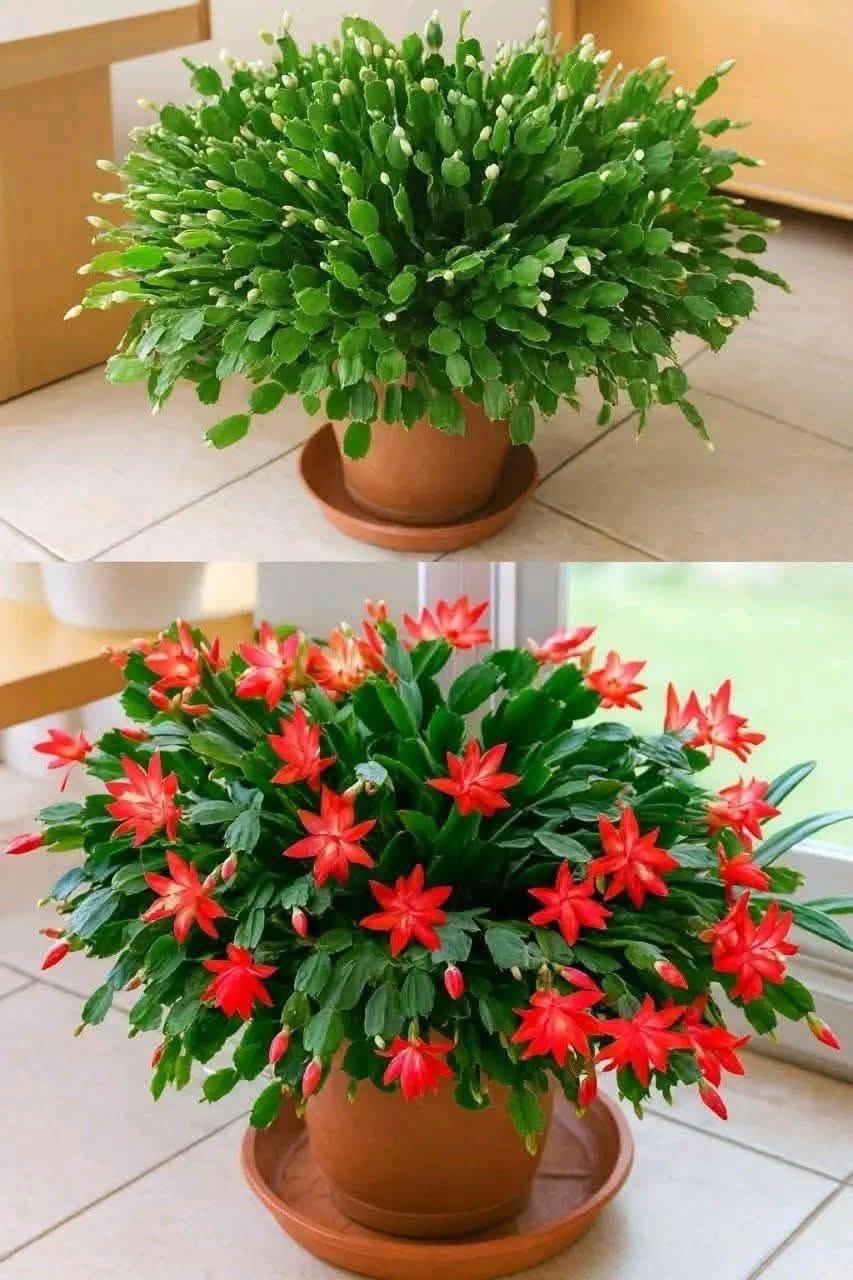The Christmas cactus is one of the most rewarding indoor plants you can grow. Those flat green segments and bright star-shaped flowers can fill a whole corner of your home with color right when you need it most. With the right care, your plant can look as full and floriferous as the ones in the picture and bloom for many years in a row.
In this guide you will learn exactly how to care for a Christmas cactus, from light and watering to repotting and getting it to bloom on time.
Choosing the Right Spot
Christmas cactus is not a desert cactus. It naturally grows in shady, humid forests, attached to trees. That means it prefers different conditions from most prickly cacti.
Place your plant in:
- Bright, indirect light
- A few hours of gentle morning sun if possible
- Away from harsh afternoon sun that can burn the segments
A north- or east-facing window is ideal. If you only have a sunny south or west window, move the pot a little back from the glass or use a sheer curtain to filter the light.
Temperature and Humidity
Christmas cactus does best in normal household temperatures, but it appreciates a little coolness, especially when forming buds.
- Ideal daytime temperature: 18–24°C (65–75°F)
- Ideal nighttime temperature: 15–18°C (60–65°F)
- Keep away from hot radiators, cold drafts and air conditioners
Because it is a forest cactus, it enjoys moderate humidity. If your home is very dry, you can place the pot on a tray filled with pebbles and water (the pot should sit on the stones, not in the water) to gently raise humidity around the plant.
Watering the Christmas Cactus
Getting the watering right is the key to a plump, healthy plant.
- Water thoroughly when the top 2–3 cm (about an inch) of soil feel dry
- Let excess water drain out of the pot; never leave the roots sitting in water
- In spring and summer, you’ll usually water more often
- In autumn and winter, watering slows down but the soil should still never stay bone dry for long
If the segments look shriveled and limp, the plant may be too dry. If they turn yellow or translucent and fall off easily, you may be overwatering. Adjust gradually until the soil is evenly moist but not soggy.
Best Soil and Pot
Christmas cactus prefers a light, airy mix that drains well.
You can use:
- A high-quality indoor potting mix with added perlite or coarse sand
- Or a half-and-half mix of cactus soil and regular potting soil
Choose a pot with drainage holes. The roots like to be slightly snug in the pot, so there is no need to repot every year. Every two to three years, repot into a container only one size larger, refreshing the soil at the same time.
Feeding for Strong Growth and Flowers
Feed your Christmas cactus during the active growing season:
- From early spring to late summer, use a balanced liquid fertilizer (for example 10-10-10 or 20-20-20) every 4–6 weeks, diluted to half the recommended strength
- Stop fertilizing at the end of summer. This rest period helps the plant prepare to set buds
Too much fertilizer, especially high in nitrogen, can cause lots of green growth but fewer flowers.
How to Get Your Christmas Cactus to Bloom
A full display of flowers doesn’t happen by accident. In nature, Christmas cactus starts forming buds when the days get shorter and cooler. You can copy these conditions at home.
About 6–8 weeks before you want blooms:
- Give the plant 12–14 hours of darkness each night. You can move it to a dark room, cover it with a box at night, or simply place it where it gets no artificial light after sunset.
- Keep the temperature slightly cooler, around 15–18°C (60–65°F).
- Water a little less, just enough to keep the soil lightly moist.
When small buds appear at the ends of the segments, move the plant back to its usual bright, indirect light. Return to normal watering, but avoid major changes in light or temperature, as this can cause buds to drop.
Pruning and Shaping
After flowering, usually in late winter, is a good time to lightly prune.
- Pinch or cut off a few segments from the ends of each stem
- This encourages branching and creates a fuller, rounded plant
- You can use the cut pieces to start new plants
Never prune heavily during bud formation or flowering, as this will remove the developing blooms.
Propagating Christmas Cactus
Christmas cactus is very easy to share with friends and family.
- Take a cutting of 2–4 joined segments.
- Let the cut end dry for a day.
- Place it in a small pot filled with slightly damp, light potting mix.
- Keep it in bright, indirect light and lightly moist.
In a few weeks, roots will form and new segments will start to grow.
Common Problems and Quick Fixes
- Buds dropping off: often caused by sudden temperature changes, moving the plant, or letting the soil get very dry or very wet. Try to keep conditions stable while the plant is budding and blooming.
- Pale or red segments: usually from too much direct sun. Move to softer light.
- Mushy stems: a sign of root rot from overwatering. Remove damaged parts, let the soil dry more between waterings, and consider repotting into fresh, well-draining mix.
Enjoying Your Flowering Christmas Cactus
With the right combination of light, water, and a short cool rest before the holidays, your Christmas cactus can reward you with a spectacular dome of flowers year after year. Place it somewhere you can admire it daily, share cuttings with friends, and enjoy one of the easiest and most impressive indoor plants you can grow.
